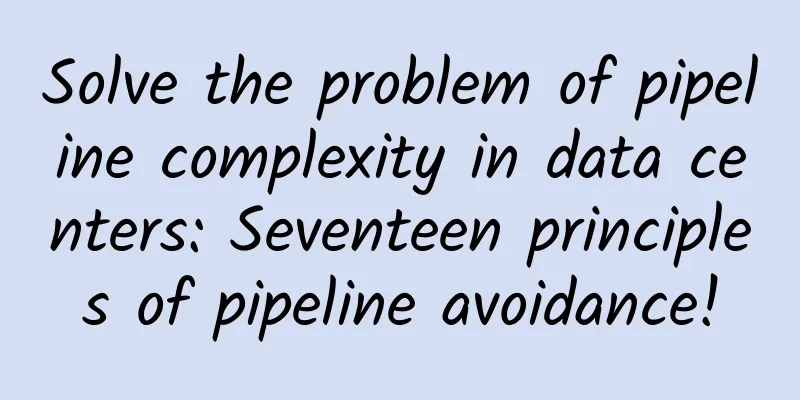Solve the problem of pipeline complexity in data centers: Seventeen principles of pipeline avoidance!

|
1. Small pipes give way to large pipes: Small pipes are easy to bend and have low cost. 2. Branch pipes give way to main pipes: Branch pipes generally have smaller diameters. The reasons for giving way to branch pipes are listed in Article 1. Another point is that the scope of influence and importance of branch pipes are not as great as those of main pipes. 3. Pressurized pipe gives way to unpressurized pipe (pressure flow pipe gives way to gravity flow pipe): Unpressurized pipe (or gravity flow pipe) changes the slope and flow direction, which has a greater impact on the flow. 4. The water supply pipe gives way to the drainage pipe: In addition to the third reason mentioned above, the drainage pipe usually has a large diameter and contains many impurities in the water. 5. Normal temperature pipes give way to high (low) temperature pipes (cold water pipes give way to hot water pipes, non-insulated pipes give way to insulated pipes): when the temperature is higher than normal, exhaust should be considered; when the temperature is lower than normal, anti-condensation insulation should be considered.
6. Low-pressure pipes give way to high-pressure pipes: High-pressure pipes are expensive and have high strength requirements. 7. Gas pipes give way to water pipes: The power consumption of water flow is high. 8. Metal pipes make non-metal pipes: Metal pipes are easy to bend, cut and connect. 9. General pipes make ventilation ducts: ventilation ducts are large and difficult to make bends. 10. Small valves give way to more valves: Consider factors such as installation, operation, and maintenance. 11. Avoid construction that is simple but difficult to construct: This is done from the perspective of avoiding increasing the difficulty of installation. 12. Let the smaller project make way for the larger one: This is done from the perspective of avoiding increasing the installation workload. 13. Pipelines with low technical requirements make way for pipelines with high technical requirements: This is to avoid increasing the difficulty of technical requirements. 14. Those with less maintenance and convenience will be replaced by those with more maintenance and inconvenience: this is considered from the perspective of post-maintenance. 15. Non-main pipelines should give way to main pipelines: This is considered from the perspective of functional importance. 16. Temporary pipelines should give way to permanent pipelines: This is considered from the perspective of the pipeline's service life. 17. New pipelines should avoid existing pipelines: This is done from the perspective of reducing construction costs, engineering workload and construction difficulty. |
<<: Five steps organizations can take to maximize data center performance
>>: Three things to consider before building a data center
Recommend
Many hands make light work, 5G bearer will gradually enter the mature stage
It has become an industry consensus that 5G will ...
Hot Topic | Why is the United States determined to "kill" Huawei?
"After reading the 20,000-word interview wit...
Easy-to-understand network protocols (TCP/IP overview)
My recent work is related to network protocols, w...
Vinton Cerf, the 'Father of the Internet', Infected with Coronavirus
[[320474]] According to the latest news from fore...
DMIT Japan International Line KVM monthly payment 20% off from $8.72, annual payment 50% off, supports PayPal/Alipay
DMIT.io is a foreign hosting company founded in 2...
In-depth | Only IT people can understand "Journey to the West"
As a TV series that has been rebroadcast thousand...
80% of the country's fiber optic access 100M broadband can't open web pages
According to data released by the Ministry of Ind...
LOCVPS Los Angeles CN2 line XEN architecture is online, Los Angeles/Osaka, Japan 30% off
The Spring Festival holiday is coming to an end. ...
SD-WAN & SASE market grew 30%, but what are the challenges behind it?
According to the latest "SASE & SD-WAN &...
127.0.0.1 and localhost, how to choose?
In actual development, we often use 127.0.0.1 and...
GSMA releases world's first new 5G network guidelines
GMSA and China Telecom have released new guidelin...
What is Wi-Fi 7, which is more powerful than Wi-Fi 6?
As we all know, Wi-Fi 6 can be said to be one of ...
Maxthon Hosting: 20% off on all VPS, CN2 lines and high-defense options available in the United States, Hong Kong, Germany, the Netherlands, etc.
Aoyozhuji is a long-established foreign VPS servi...









